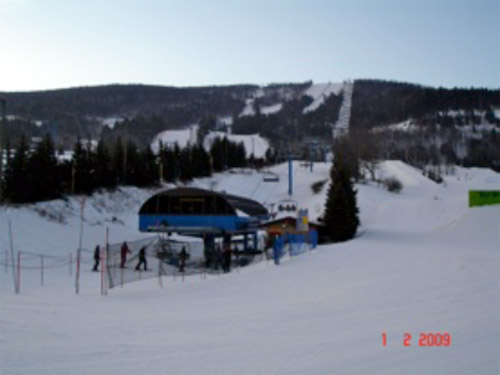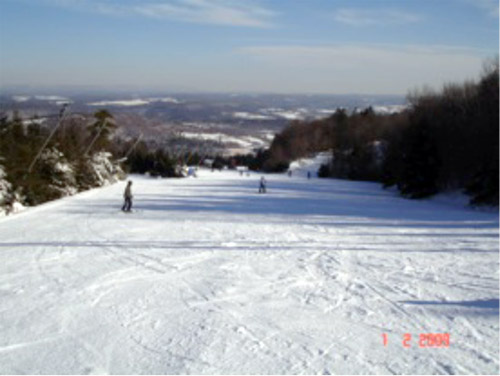On February 1, 2009, a family ski event took the writer and close friends to Blue Mountain, PA. Blue Mountain is not as marketed as other ski resorts but it should be. It’s a ski area worth visiting in the Poconos Mountains, relatively close (less than 4 hours) to DC, Baltimore, and Philadelphia.
Blue Mountain is as good as anyone will find in PA, if not the mid-Atlantic. Standing alone, it is a good to very good area. Standing in competition within its Eastern US location, it is a very good to excellent area. Along with the highest vertical in the Commonwealth of Pennsylvania, it features some standout features, such as one of the very few detachable six packs in the East, two lodges, and terrain to suit all likes. The resort has been in a period of expansion and it is obvious where the future growth of the resort is headed, as the new six-pack and high-speed quad are in that area. There are several mile-long runs for beginners, great groomers and challenges for intermediate skiers, and steeps for experts.
There are some drawbacks that this article points out and all are management related, hopefully management is or may become aware of them, will respond to them and make the resort even better. A ski resort is a very complex operation. Yes, some facets may not be as well run as others, but despite that, there are countless dedicated people who make a ski resort run, and many of them are volunteers. Taking time to talk to some of the patrollers, it was obvious that they were very proud of their mountain.
Getting there is made easy with a network of excellent roads. The entire trip from Philadelphia was on either Interstate or four-lane divided highways except the last 10 miles to the resort. We left Philadelphia at 6:15 am, arriving at the lower lodge at 7:30, with plenty of time to have a bite to eat and relax a bit before the 8 am opening of the lifts.

|
|
Ticket machines at Blue Mountain lower lodge. Photo provided by Lou Botta.
|
Parking on the lower lodge was very easy early in the morning; we secured parking less than 100 feet from the lodge. Once inside the lower lodge, we found numerous lockers to stow personal effects right by the ticket area and connected to the restaurant complex. A unique feature in the resort is the automated ticket machines for web ticketing. The resort still has many different options for ticketing: Morning, Day, Afternoon, Twilight, All Day/Night and Night only. It also offer children and senior discounts.
Once outside, it is obvious the resort makes up for its lack of natural snow with massive snowmaking. Throughout the day, I was not able to find a thin patch of snow cover. Snow base was excellent throughout the mountain. Another notable fact is that 100 percent of the terrain is lighted for night operations. To our left, a massive tubing park was opening up, serviced by two tows and a conveyor lift. Judging by the number of children and parents headed that way, it was obvious is is a major resort attraction.
An interesting feature at Blue Mountain was the ticket check-ins. There were two, outside of each lodge. The geography of the resort allows for these two central points to check tickets. Then we did not have to show a lift ticket until we were back in one of the lodges.

|
|
Challenge Express six-pack high-speed lift. Photo provided by Lou Botta.
|
We made our way to the Challenge Express high-speed six-pack and were on top of the mountain in no time. Our first run to check the conditions and get our ski legs was the mile-plus green run Paradise, winding its way down the entire vertical of the mountain. No wait on the Six-pack so it was back up again to try their blue run Dream Weaver. As in all the runs in the morning, they were meticulously groomed to corduroy. Then it was time for our group to split up and allow some of us to tackle some of the more challenging runs. Razor’s Edge and Challenge, both rated double diamonds, were quite steep, but groomed to perfection. These two runs parallel each other and are between the Six-pack and the Comet Quad.
It is obvious that the resort operators are planning on further expansion, as the two new high-speed quads are towards the end of the resort and there is evidence of further expansion and exploration. As well, there is a new, twisting run still under construction, seemingly a New England-type narrower run, possibly a single diamond. It will be a pleasure to ski down that new run soon.
After several runs down the double-blacks, we began to explore the runs further to the South. Sidewinder Park is a boarder’s heaven, but there is still enough for skiers to enjoy. The lower part of Sidewinder is extremely twisty and the run itself banks with the turn. Few places offer this feature.
Around 9:30 am, the six-pack and its sister high-speed quad began to get busy, so we headed further South. A single black-diamond cutoff takes the skier to the old part of the resort, serviced by parallel older twin chairs, Main Street and Burma. These chairs are located about 200 feet higher than the lower lodge, making them a separate part of the resort. Although slow, the twin nature of these lifts allows a large number of skiers to ascend to the top at the same time. The terrain available here is mainly blue and black, with narrower, yet very well groomed runs.
The blue-rated Lazy Mile connected with the six-pack lift territory and the main lodge, while the rest, Switchback (blue); Barney’s Bumps, on one side of Main Street (both black diamonds); Come Around (blue) and Raceway (black diamond); connect to the double chairs. Another long green, Burma Road, allows skiers to remain on the twin chair territory. The upper lodge is on the southern side of these runs, and is a totally independent operation. For brand new skiers, there are two school territories, next to each lodge.
We had a snack at the upper lodge, with awesome views of the Pocono Mountains and the valley below. Although dated, the lodge is nevertheless very functional. This was followed by more skiing on the upper terrain, which maintained its snow cover despite an increasing amount of skiers and boarders.
By 2 pm, however, we had our fun of the upper territory and went back inside the main lodge. What awaited us was amazingly long lines on the six-pack and the quad, so we called it quits and had a late lunch before we went back to Philadelphia.
It is worth noting that at both lodges, there is complimentary ski and board check-in with generous tipping allowed. No lines at the check-in, and our equipment was safe.
At the lower lodge, and besides the general industrial food available in ski cafeterias, there were several independent concessionaires outside. I fixed my eyes on the roasted nut trailer, where roasted, caramelized cashews, almonds and peanuts were sold. Hot, fresh from the oven. These are an outstanding addition to any resort.

|
|
View of the Poconos from Lower Main Street. Photo provided by Lou Botta.
|
Overall, I was impressed by the quality of the snow cover at Blue Mountain, as well as the grooming on all the runs. The staff was friendly, knowledgeable and courteous. And my conversation with the ski patrol members indicated a strong sense of pride on their mountain.
However, there are some drawbacks to be considered. For starters, get there early. On weekends, the crowds are enormous. The detachable six-pack and quad are on the newer part of the resort, away from most of the trails, so it is a hike to most of the uncrowded areas. With hopefully new trails becoming operative, the newer part of the mountain will have enough to sustain the crowds.
The most frustrating part of Blue Mountain was the lodges. There is no resort enforcement on personal effects left on tables in the dining rooms. People come in and mark their territory by dropping their personal gear on the dining tables, chairs, or on the way around the tables to make it hard for people to walk to these tables. Besides being a fire hazard, it is unconscionable. And as a result, there’s no place to sit for lunch. Meanwhile the many lockers available are left unused.
Blue Mountain is a venerable place on the road to reinventing itself. With additional construction and management emphasis on customer service, it is on the way to becoming an outstanding mountain.
While actually born in the tropics (Cuba), Lou grew up in New England and went to College in Vermont, where he initially took up skiing. He then embarked on a twenty-two year Air Force piloting career that took him to over 50 countries. He has skied in Europe and America (both North and South). His second career as a senior officer with the Federal Government spanned thirteen years and in 2010, Lou retired to pursue a more leisurely life style.